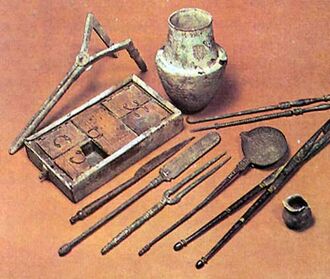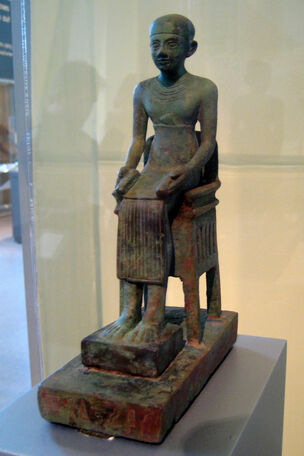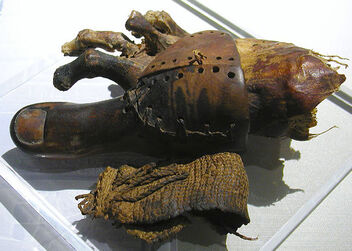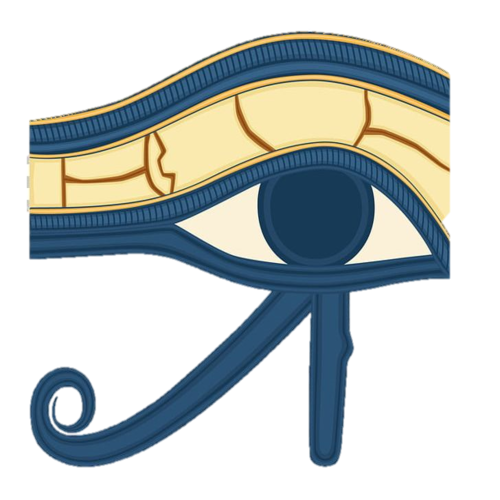
Egyptian medical tools
The medicine of the ancient Egyptians is some of the oldest documented. From the beginnings of the civilization in the c. 33rd century BC until the Persian invasion of 525 BC, Egyptian medical practice went largely unchanged but was highly advanced for its time, including simple non-invasivesurgery,
setting of bones and an extensive set of pharmacopoeia. Egyptian medical thought influenced later traditions, including the Greeks.
Sources of information[]
Until the 19th century, the main sources of information about ancient Egyptian medicine were writings from later in antiquity. Homer c. 800 BC remarked in the Odyssey: "In Egypt, the men are more skilled in medicine than any of human kind" and "the Egyptians were skilled in medicine more than any other art". The Greek historian Herodotus visited Egypt around 440 BC and wrote extensively of his observations of their medicinal practices. Pliny the Elder also wrote favourably of them

Egyptian medical tools, circa Ptolemy Period
in historical review. Hippocrates (the "father of medicine"), Herophilos, Erasistratus and later Galen studied at the temple of Amenhotep, and acknowledged the contribution of ancient Egyptian medicine to Greek medicine.
In 1822, the translation of the Rosetta stone finally allowed the translation of ancient Egyptian hieroglyphic inscriptions and papyri, including many related to medical matters (Egyptian medical papyri). The resultant interest in Egyptology in the 19th century led to the discovery of several sets of extensive ancient medical documents, including the Ebers papyrus, the Edwin Smith Papyrus, the Hearst Papyrus, the London Medical Papyrus and others dating back as far as 2900 BC. The Edwin Smith Papyrus is a textbook on surgery and details anatomical observations and the "examination, diagnosis, treatment, and prognosis" of numerous ailments. It was probably written around 1600 BC, but is regarded as a copy of several earlier texts. Medical information in it dates from as early as 3000 BC. Imhotep in the 3rd dynasty is credited as the original author of the papyrus text, and founder of ancient Egyptian medicine. The earliest known

Egyptian medical tools
surgery was performed in Egypt around 2750 BC.
The Ebers papyrus c. 1550 BC is full of incantations and foul applications meant to turn away disease-causing demons, and also includes 877 prescriptions. It may also contain the earliest documented awareness of tumors, if the poorly understood ancient medical terminology has been correctly interpreted. Other information comes from the images that often adorn the walls of Egyptian tombs and the translation of the accompanying inscriptions. Advances in modern medical technology also contributed to the understanding of ancient Egyptian medicine. Paleopathologists were able to use X-Rays and later CAT Scans to view the bones and organs of mummies. Electron microscopes, mass spectrometry and various forensic techniques allowed scientists unique glimpses of the state of health in Egypt 4000 years ago.
Other documents as the Edwin Smith papyrus (1550 BC), Hearst papyrus (1450 BC), and Berlin Papyrus (1200 BC) also provide valuable insight into ancient Egyptian medicine. The Edwin Smith papyrus for example mentioned research methods, the making of a diagnosis of the patient, and the setting of a treatment. It is thus viewed as a learning manual. Treatments consisted of ailments made from i.e. animal, vegetable or fruit substances or minerals.
Nutrition[]

A bee as depicted in the White Chapel
Fundamentally when considering the health of any culture nutrition must be discussed. The Ancient Egyptians were at least partially aware of the importance of diet, both in balance and moderation. Owing to Egypt's great endowment of fertile land, food production was never a major issue although of course no matter how bounteous the land, paupers and starvation still exist. The main crops for most of ancient Egyptian history were emmer wheat and barley. Consumed in the form of loaves which were produced in a variety of types through baking and fermentation, with yeast greatly enriching the nutritional value of the product, one farmer's crop could support an estimated twenty adults. Barley was also used in beer. Vegetables and fruits of many types were widely grown. Oil was produced from the linseed plant and there was a limited selections of spices and herbs. Meat (sheep, goats, pigs, wild game) was regularly available to at least the upper classes and fish were widely consumed, although there is evidence of prohibitions during certain periods against certain types of animal products; Herodotus wrote of the pig as being 'unclean'. Offerings to King Unas (c. 2494–2345 BC) were recorded as
“...milk, three kinds of beer, five kinds of wine, ten loaves, four of bread, ten of cakes four meats, different cuts, joints, roast, spleen, limb, breast, quail, goose, pigeon, figs, ten other fruits, three kinds of corn, barley, spelt, five kinds of oil, and fresh plants...” It is clear that the Egyptian diet was not lacking for the upper classes and that even the lower classes may have had some selection (Nunn, 2002).
Practices[]
Medical knowledge in ancient Egypt had an excellent reputation, and rulers of other empires would ask the Egyptian

An Egyptian doctor with a medical tool
pharaoh to send them their best physician to treat their loved ones. Egyptians had some knowledge of human anatomy. For example, in the classic mummification process, mummifiers knew how to insert a long hooked implement through a nostril, breaking the thin bone of the brain case and remove the brain. They also must have had a general idea of the location in the body cavity of the inner organs, which they removed through a small incision in the left groin. But whether this knowledge was passed on to the practitioners of medicine is unknown and does not seem to have had any impact on their medical theories.
Egyptian physicians were aware of the existence of the pulse and of a connection between pulse and heart. The author of the Smith Papyrus even had a vague idea of a cardiac system, although not of blood circulation and he was unable, or deemed it unimportant, to distinguish between blood vessels, tendons, and nerves. They developed their theory of "channels" that carried air, water and blood to the body by analogies with the… River Nile; if it became blocked, crops became unhealthy and they applied this principle to the body: If a person was unwell, they would use laxatives to unblock the "channels".
Quite a few medical practices were effective, such as many of the surgical procedures given in the Edwin Smith papyrus. Mostly, the physicians' advice for staying healthy was to wash and shave the body, including under the arms, and this may have prevented infections. They also advised patients to look after their diet, and avoid foods such as raw fish or other animals considered to be unclean.
Many practices were ineffective or harmful. Michael D. Parkins says that 72% of 260 medical prescriptions in the Hearst Papyrus had no known curative elements, and many contained animal dung which contains products of fermentation and molds, some of them having curative properties, but also bacteria posing a grave threat of infection.
Surgery[]

Egyptian surgery to the head
The oldest metal (Bronze or copper) surgical tools in the world were discovered in the tomb of Qar. Surgery was a common practice among physicians as treatment for physical injuries. The Egyptian physicians recognized three categories of injuries; treatable, contestable, and untreatable ailments. Treatable ailments the surgeons
would quickly set to right. Contestable ailments were those where the victim could presumably survive without treatment, so patients assumed to be in this category were observed and if they survived then surgical attempts could be made to fix the problem with them. They used knives, hooks, drills, forceps, pincers, scales, spoons, saws and a vase with burning incense.
Prosthetics, such as artificial toes and eyeballs, were also used; typically, they served little more than decorative purposes. In preparation for burial, missing body parts would be replaced (but these do not appear as if they would have been useful, or even attachable) before death.
The extensive use of surgery, mummification practices, and a

utopsy as a religious exercise gave Egyptians a vast knowledge of the body's morphology, and even a considerable understanding of organ functions. The function of most major organs was correctly presumed—for example, blood was correctly guessed to be a transpiration medium for vitality and waste which is not too far from its actual role in carrying oxygen and removing carbon dioxide—with the exception of the heart and brain whose functions were switched.
Dentistry[]

Egyptian dentistry
Dentistry was an important field, as an independent profession it dated from the early 3rd millennium BC, although it may not have never been prominent. The Egyptian diet was high in abrasives (such as sand left over from grinding grain and bits of rocks in which the way bread was prepared) and so the condition of their teeth was quite poor, although archaeologists have noted a steady decrease in severity and incidence of worn teeth throughout 4000 BC to 1000 AD, probably due to improved grain grinding techniques. All Egyptian remains have sets of teeth in quite poor states. Dental disease could even be fatal, such as for Djedmaatesankh, a musician from Thebes, who died around the age of thirty five from extensive dental disease and a large infected cyst. If an individual's teeth escaped being worn down, cavities were rare, due to the rarity of sweeteners. Dental treatment was infective and the best sufferers could hope for was the quick loss of an infected tooth. The Instruction of Ankhsheshonq contains the maxim "There is no tooth that rots yet stays in place". No records document the hastening of this process and no tools suited for the extraction of teeth have been found, though some remains show sign of forced tooth removal.[15] Replacement teeth have been found, although it is not clear whether they are just post-mortem cosmetics. Extreme pain might have been medicated with opium.
Magic and Religion[]

Imhotep, the Egyptian father of medicine
Magic and religion were an integral part of everyday life in ancient Egypt. Evil gods and demons were thought to be responsible for many ailments, so often the treatments involved a supernatural element, such as beginning treatment with an appeal to a deity. There does not appear to have existed a clear distinction between what nowadays one would consider the very distinct callings of priest and physician. The healers, many of them priests of Sekhmet, often used incantations and magic as part of treatment.
The widespread belief in magic and religion may have resulted in a powerful placebo effect; that is, the perceived validity of the cure may have contributed to its effectiveness. The impact of the emphasis on magic is seen in the selection of remedies or ingredients for them. Ingredients were sometimes selected seemingly because they were derived from a substance, plant or animal that had characteristics which in some way corresponded to the symptoms of the patient. This is known as the principle of simila similibus ("similar with similar") and is found throughout the history of medicine up to the modern practice of homeopathy. Thus an ostrich egg is included in the treatment of a broken skull, and an amulet portraying a hedgehog might be used against baldness. Amulets in general were very popular, they were worn for many magical purposes. Health related amulets are classified as homeopoetic, phylactic and theophoric. Homeopoetic amulets portray an animal or part of an animal, from which the wearer hopes to gain positive attributes like strength or speed. Phylactic amulets protected against harmful gods and demons. The famous Eye of Horus was often used on a phylactic amulet. Theophoric amulets represented Egyptian gods; one represented the girdle of Isis and was intended to stem the flow of blood at miscarriage. They were often made of bone, hanging from a leather strap.
Doctors and other healers[]

A Egyptian Prosthetic toe, used to aid walking
The ancient Egyptian word for doctor is "wabau". This title has a long history. The earliest recorded physician in the world, Hesy-Ra, practiced in ancient Egypt. He was “Chief of Dentists and Physicians” to King Djoser, who ruled in the 27th century BC. The lady Peseshet (2400 BC) may be the first recorded female doctor: she was possibly the mother of Akhethotep, and on a stela dedicated to her in his tomb she is referred to as imy-r swnwt, which has been translated as “Lady Overseer of the Lady Physicians” (swnwt is the feminine of swnw).
There were many ranks and specializations in the field of medicine. Royalty employed their own swnw, even their own specialists. There were inspectors of doctors, overseers and chief doctors. Known ancient Egyptian specialists are ophthalmologist, gastroenterologist, proctologist, dentist, "doctor who supervises butchers" and an unspecified "inspector of liquids". The ancient Egyptian term for proctologist, neru phuyt, literally translates as "shepherd of the anus". Institutions, so called Houses of Life, are known to have been established in ancient Egypt since the 1st Dynasty and may have had medical functions, being at times associated in inscriptions with physicians, such as Peftauawyneit and Wedjahorresnet living in the middle of the 1st millennium BC. By the time of the 19th Dynasty their employees enjoyed such benefits as medical insurance, pensions and sick leave.
